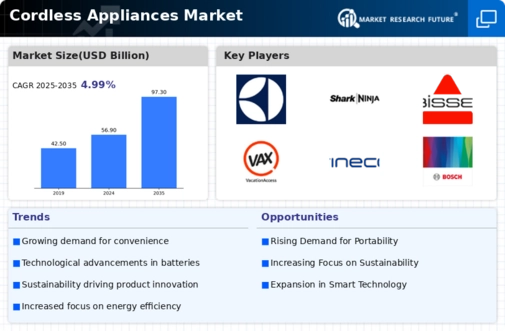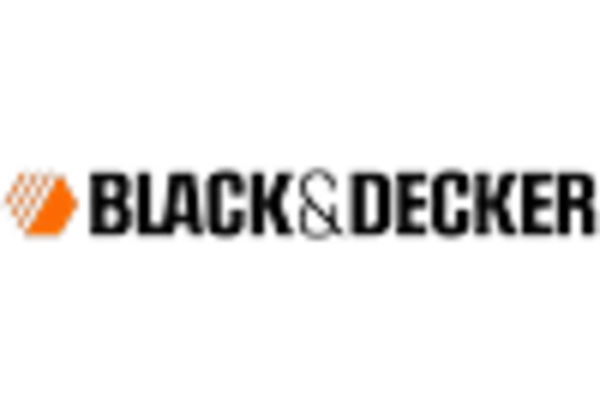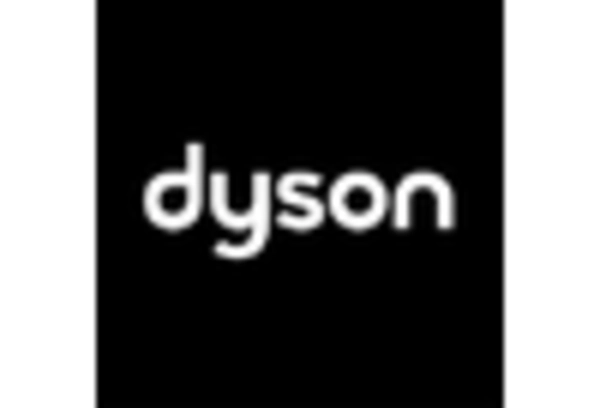Integration of Smart Technology
The integration of smart technology is transforming the Cordless Appliances Market. Consumers increasingly seek appliances that offer connectivity and automation features, allowing for enhanced user experiences. Smart cordless appliances, equipped with Wi-Fi and Bluetooth capabilities, enable users to control devices remotely through smartphones or voice-activated assistants. This trend is reflected in market data, which shows that the smart appliance segment is expected to grow by 20% annually. The convenience of monitoring and controlling appliances from anywhere adds a layer of appeal for tech-savvy consumers. As manufacturers continue to innovate and incorporate smart features into their cordless products, the market is likely to see a significant shift towards more intelligent and user-friendly appliances.
Growing Focus on Health and Hygiene
The Cordless Appliances Market is witnessing a growing focus on health and hygiene, particularly in the wake of heightened awareness regarding cleanliness. Cordless appliances, such as handheld vacuum cleaners and steam mops, are increasingly favored for their ability to provide quick and efficient cleaning solutions. This trend is supported by market data indicating that the demand for cordless cleaning devices has risen by approximately 15% in recent years. Consumers are more inclined to invest in appliances that facilitate easy maintenance of their living spaces, thereby promoting a healthier environment. Additionally, the convenience of cordless appliances allows for more frequent cleaning, which aligns with the rising consumer emphasis on hygiene and cleanliness in both residential and commercial settings.
Rising Consumer Demand for Convenience
The Cordless Appliances Market experiences a notable surge in consumer demand for convenience-driven products. As lifestyles become increasingly fast-paced, consumers seek appliances that offer ease of use and mobility. Cordless appliances, such as vacuum cleaners and kitchen gadgets, provide the flexibility to operate without being tethered to a power source. This trend is reflected in market data, indicating that the cordless vacuum cleaner segment alone is projected to grow at a compound annual growth rate of 8.5% over the next five years. The desire for convenience is further amplified by the growing trend of urbanization, where smaller living spaces necessitate compact and efficient appliances. Consequently, manufacturers are focusing on developing innovative cordless solutions that cater to this evolving consumer preference.
Sustainability and Eco-Conscious Consumerism
Sustainability plays a pivotal role in shaping the Cordless Appliances Market. As consumers become more eco-conscious, there is a growing demand for appliances that are energy-efficient and environmentally friendly. Manufacturers are responding by developing cordless appliances that utilize sustainable materials and energy-efficient technologies. Market data indicates that eco-friendly appliances are projected to capture a larger market share, with an expected growth rate of 12% over the next five years. This shift towards sustainability not only appeals to environmentally aware consumers but also aligns with regulatory trends favoring energy-efficient products. Consequently, the integration of sustainable practices in the production of cordless appliances is likely to enhance brand loyalty and attract a broader customer base.
Technological Innovations in Battery Technology
Technological advancements in battery technology significantly influence the Cordless Appliances Market. The development of lithium-ion batteries has revolutionized the performance and longevity of cordless appliances. These batteries offer higher energy density, faster charging times, and longer lifespans compared to traditional battery types. As a result, consumers are increasingly attracted to cordless appliances that can operate for extended periods without frequent recharging. Market data suggests that the battery segment within the cordless appliance industry is expected to witness a growth rate of 10% annually, driven by these innovations. Furthermore, manufacturers are investing in research and development to enhance battery efficiency, which is likely to lead to the introduction of next-generation cordless appliances that meet the demands of modern consumers.


















Leave a Comment